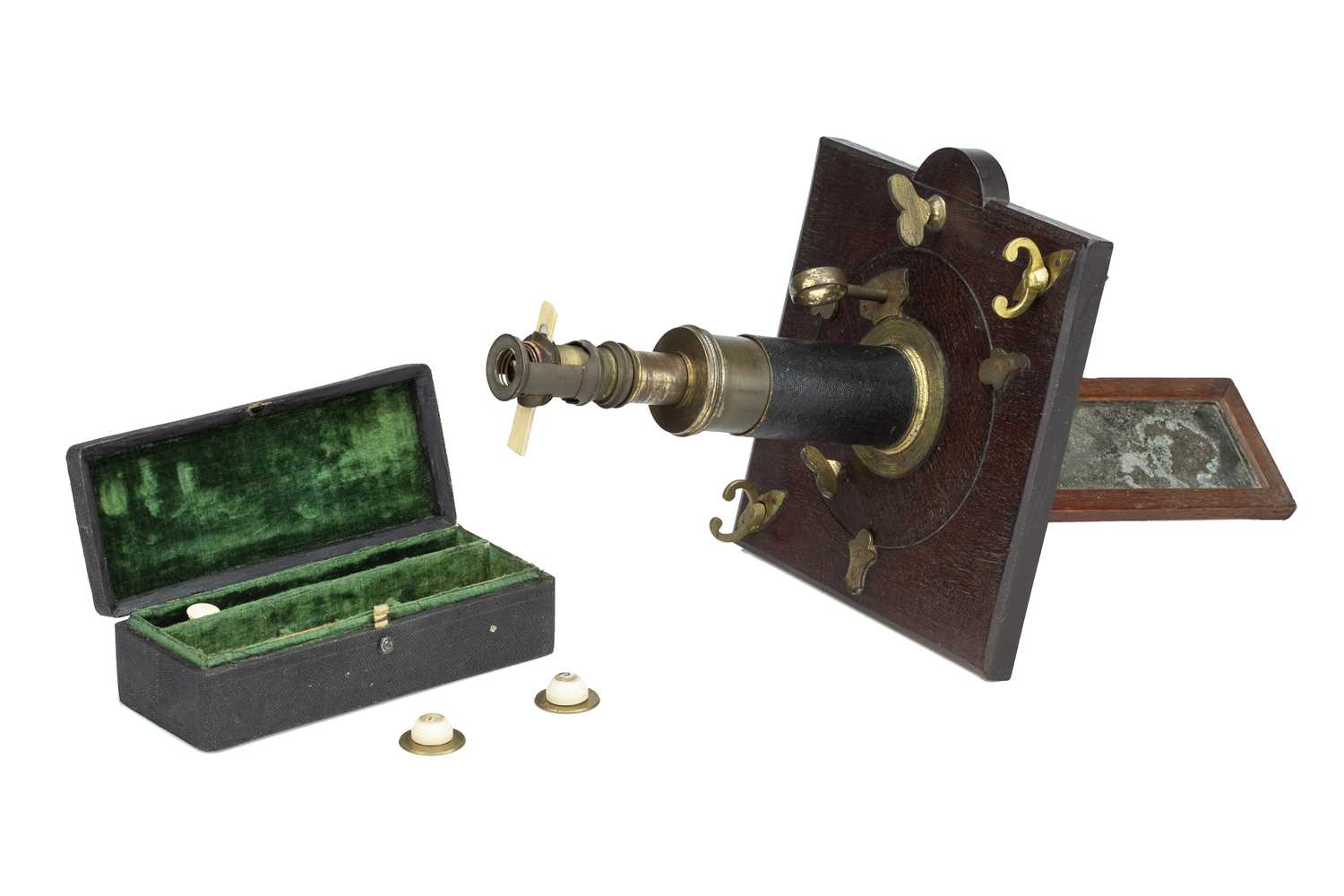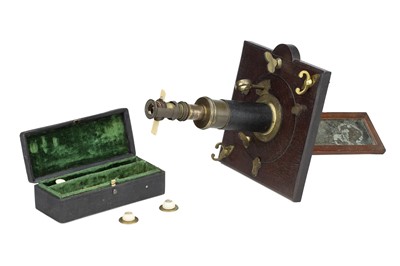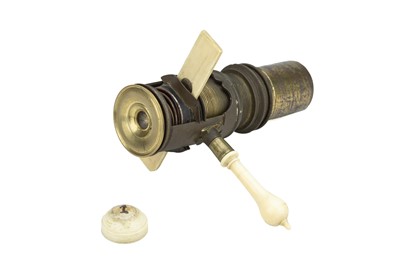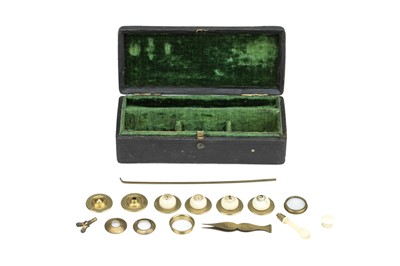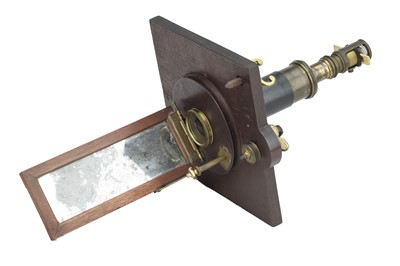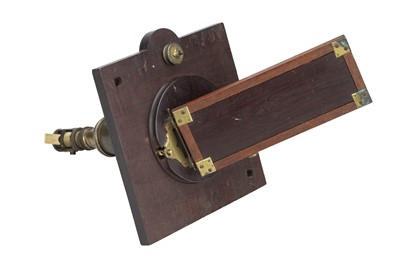12th May, 2022 12:00
Fine Scientific and Medical Instruments
An Important John Cuff 'First Form', Solar Microscope
English, c.1743, unsigned but by Cuff, the square solid mahogany plate with a rotating centre mounted to the front with a brass flange into which screws the main body of the microscope constructed of brass with leather covering, a drawer tube had a mount at the front onto which fits the Wilson-type screw barrel microscope, at the rear of the microscope is a single condenser lens in a brass frame and the adjustable mirror in a brass-bound frame, with a sharkskin covered case lined with green silk velvet with 6 objectives, handle for the Wilson microscope, talk box, tweezers, mahogany plate 20cm x 20cm. [CITES]
Note: This lot contains or is made of ivory and cannot be imported into the USA or any country within the EU.
Footnotes:
According to Clay & Court, in their book, ‘The History of the microscope’ an identical instrument belonged to George the III[i] and formed part of the Frank Crisp Collection, which after Crisps death, was sold at Stevens Auctions in 1925. The microscope was bought at the sale by the Science Museum and is now in their collections [ii].
The Cuff microscope, now in the science museum collection, is described in great depth by Clay & Court on pages 215-217, of their book, and includes an image of an identical instrument that they refer to as ‘Cuff Solar, First Form’, Clay and Court go on to state “The Solar Microscope.-Cuff appears to have been the originator of this form of solar microscope in which the tube was fixed, and the motion of the sun in the Heavens was allowed for by adjusting the mirror. One of the original forms of solar microscopes of Cuff’s make is illustrated in fig 1.48. It is mounted on a mahogany plate which I about eight inches square….”.
Clay and Court also allude to an original document held in the British Museum, dated 1743, in which Cuff claims “ I added a mirror to an ingenious suggestion of a friend who had introduced me to Dr. Leiberkuhn, and with the assistance of several Gentlemen of the greatest understanding and ability, I had been able to alter and improve it from time to time”.
John Cuff (c. 1708 – c. 1772) was an important English scientific instrument maker during the 18th Century. Although he made all types of instruments today he is best known for his contribution to microscope design. In particular with his Solar or Camera Obscura microscope and his double microscope that became known as the ‘Cuff-type’.
Unfortunately, Cuff was apparently not much of a businessman. Despite his ability, expertise, and patronage of the naturalist Henry Baker in 1750 he had to declare himself bankrupt [iii], just a year after, the main competitor of his, Benjamin Martin, opened a shop next door.
[i] from Clay & Court s book ‘The History of the Microscope’, from the Preface.
[ii] Science Museum South Kensington, London collection, inv.no. A203100
[iii] https://www.whipplemuseum.cam.ac.uk/explore-whipple-collections/microscopes/three-microscope-makers/john-cuff-and-new-constructed
Sold for £5,500
Result plus buyers premium
English, c.1743, unsigned but by Cuff, the square solid mahogany plate with a rotating centre mounted to the front with a brass flange into which screws the main body of the microscope constructed of brass with leather covering, a drawer tube had a mount at the front onto which fits the Wilson-type screw barrel microscope, at the rear of the microscope is a single condenser lens in a brass frame and the adjustable mirror in a brass-bound frame, with a sharkskin covered case lined with green silk velvet with 6 objectives, handle for the Wilson microscope, talk box, tweezers, mahogany plate 20cm x 20cm. [CITES]
Note: This lot contains or is made of ivory and cannot be imported into the USA or any country within the EU.
Footnotes:
According to Clay & Court, in their book, ‘The History of the microscope’ an identical instrument belonged to George the III[i] and formed part of the Frank Crisp Collection, which after Crisps death, was sold at Stevens Auctions in 1925. The microscope was bought at the sale by the Science Museum and is now in their collections [ii].
The Cuff microscope, now in the science museum collection, is described in great depth by Clay & Court on pages 215-217, of their book, and includes an image of an identical instrument that they refer to as ‘Cuff Solar, First Form’, Clay and Court go on to state “The Solar Microscope.-Cuff appears to have been the originator of this form of solar microscope in which the tube was fixed, and the motion of the sun in the Heavens was allowed for by adjusting the mirror. One of the original forms of solar microscopes of Cuff’s make is illustrated in fig 1.48. It is mounted on a mahogany plate which I about eight inches square….”.
Clay and Court also allude to an original document held in the British Museum, dated 1743, in which Cuff claims “ I added a mirror to an ingenious suggestion of a friend who had introduced me to Dr. Leiberkuhn, and with the assistance of several Gentlemen of the greatest understanding and ability, I had been able to alter and improve it from time to time”.
John Cuff (c. 1708 – c. 1772) was an important English scientific instrument maker during the 18th Century. Although he made all types of instruments today he is best known for his contribution to microscope design. In particular with his Solar or Camera Obscura microscope and his double microscope that became known as the ‘Cuff-type’.
Unfortunately, Cuff was apparently not much of a businessman. Despite his ability, expertise, and patronage of the naturalist Henry Baker in 1750 he had to declare himself bankrupt [iii], just a year after, the main competitor of his, Benjamin Martin, opened a shop next door.
[i] from Clay & Court s book ‘The History of the Microscope’, from the Preface.
[ii] Science Museum South Kensington, London collection, inv.no. A203100
[iii] https://www.whipplemuseum.cam.ac.uk/explore-whipple-collections/microscopes/three-microscope-makers/john-cuff-and-new-constructed
Auction: Fine Scientific and Medical Instruments, 12th May, 2022
